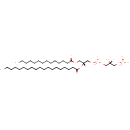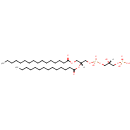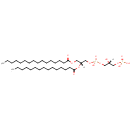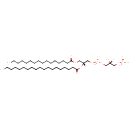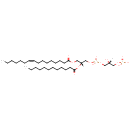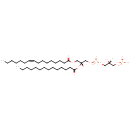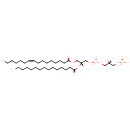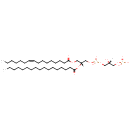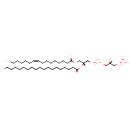
Search Results for compounds
Searching compounds for
returned 4373 results.
Displaying compounds 2461 - 2470 of
4373 in total
PGP(14:0/19:0) (PAMDB006404)
IUPAC:
[(2R)-2-hydroxy-3-({hydroxy[(2R)-2-(nonadecanoyloxy)-3-(tetradecanoyloxy)propoxy]phosphoryl}oxy)propoxy]phosphonic acid
CAS: Not Available
Description: PGP(14:0/19:0) belongs to the class of glycerophosphoglycerophosphates, also called phosphatidylglycerophosphates (PGPs). These lipids contain a common glycerophosphate skeleton linked to at least one fatty acyl chain and a glycero-3-phosphate moiety. As is the case with diacylglycerols, phosphatidylglycerophosphates can have many different combinations of fatty acids of varying lengths and saturation attached to the C-1 and C-2 positions. PGP(14:0/19:0), in particular, consists of one tetradecanoyl chain to the C-1 atom, and one nonadecanoyl to the C-2 atom. In Pseudomonas aeruginosa, PGPs can be found in the cytoplasmic membrane. The are synthesized by the addition of glycerol 3-phosphate to a CDP-diacylglycerol. In turn, PGPs are dephosphorylated to Phosphatidylglycerols (PGs) by the enzyme Phosphatidylglycerophosphatase.
PGP(16:0/14:0) (PAMDB006405)
IUPAC:
[(2R)-3-({[(2R)-3-(hexadecanoyloxy)-2-(tetradecanoyloxy)propoxy](hydroxy)phosphoryl}oxy)-2-hydroxypropoxy]phosphonic acid
CAS: Not Available
Description: PGP(16:0/14:0) belongs to the class of glycerophosphoglycerophosphates, also called phosphatidylglycerophosphates (PGPs). These lipids contain a common glycerophosphate skeleton linked to at least one fatty acyl chain and a glycero-3-phosphate moiety. As is the case with diacylglycerols, phosphatidylglycerophosphates can have many different combinations of fatty acids of varying lengths and saturation attached to the C-1 and C-2 positions. PGP(16:0/14:0), in particular, consists of one hexadecanoyl chain to the C-1 atom, and one tetradecanoyl to the C-2 atom. In Pseudomonas aeruginosa, PGPs can be found in the cytoplasmic membrane. The are synthesized by the addition of glycerol 3-phosphate to a CDP-diacylglycerol. In turn, PGPs are dephosphorylated to Phosphatidylglycerols (PGs) by the enzyme Phosphatidylglycerophosphatase.
PGP(16:0/15:0) (PAMDB006406)
IUPAC:
[(2R)-3-({[(2R)-3-(hexadecanoyloxy)-2-(pentadecanoyloxy)propoxy](hydroxy)phosphoryl}oxy)-2-hydroxypropoxy]phosphonic acid
CAS: Not Available
Description: PGP(16:0/15:0) belongs to the class of glycerophosphoglycerophosphates, also called phosphatidylglycerophosphates (PGPs). These lipids contain a common glycerophosphate skeleton linked to at least one fatty acyl chain and a glycero-3-phosphate moiety. As is the case with diacylglycerols, phosphatidylglycerophosphates can have many different combinations of fatty acids of varying lengths and saturation attached to the C-1 and C-2 positions. PGP(16:0/15:0), in particular, consists of one hexadecanoyl chain to the C-1 atom, and one pentadecanoyl to the C-2 atom. In Pseudomonas aeruginosa, PGPs can be found in the cytoplasmic membrane. The are synthesized by the addition of glycerol 3-phosphate to a CDP-diacylglycerol. In turn, PGPs are dephosphorylated to Phosphatidylglycerols (PGs) by the enzyme Phosphatidylglycerophosphatase.
PGP(16:0/17:0) (PAMDB006407)
IUPAC:
[(2R)-3-({[(2R)-2-(heptadecanoyloxy)-3-(hexadecanoyloxy)propoxy](hydroxy)phosphoryl}oxy)-2-hydroxypropoxy]phosphonic acid
CAS: Not Available
Description: PGP(16:0/17:0) belongs to the class of glycerophosphoglycerophosphates, also called phosphatidylglycerophosphates (PGPs). These lipids contain a common glycerophosphate skeleton linked to at least one fatty acyl chain and a glycero-3-phosphate moiety. As is the case with diacylglycerols, phosphatidylglycerophosphates can have many different combinations of fatty acids of varying lengths and saturation attached to the C-1 and C-2 positions. PGP(16:0/17:0), in particular, consists of one hexadecanoyl chain to the C-1 atom, and one heptadecanoyl to the C-2 atom. In Pseudomonas aeruginosa, PGPs can be found in the cytoplasmic membrane. The are synthesized by the addition of glycerol 3-phosphate to a CDP-diacylglycerol. In turn, PGPs are dephosphorylated to Phosphatidylglycerols (PGs) by the enzyme Phosphatidylglycerophosphatase.
PGP(16:0/19:0) (PAMDB006408)
IUPAC:
[(2R)-3-({[(2R)-3-(hexadecanoyloxy)-2-(nonadecanoyloxy)propoxy](hydroxy)phosphoryl}oxy)-2-hydroxypropoxy]phosphonic acid
CAS: Not Available
Description: PGP(16:0/19:0) belongs to the class of glycerophosphoglycerophosphates, also called phosphatidylglycerophosphates (PGPs). These lipids contain a common glycerophosphate skeleton linked to at least one fatty acyl chain and a glycero-3-phosphate moiety. As is the case with diacylglycerols, phosphatidylglycerophosphates can have many different combinations of fatty acids of varying lengths and saturation attached to the C-1 and C-2 positions. PGP(16:0/19:0), in particular, consists of one hexadecanoyl chain to the C-1 atom, and one nonadecanoyl to the C-2 atom. In Pseudomonas aeruginosa, PGPs can be found in the cytoplasmic membrane. The are synthesized by the addition of glycerol 3-phosphate to a CDP-diacylglycerol. In turn, PGPs are dephosphorylated to Phosphatidylglycerols (PGs) by the enzyme Phosphatidylglycerophosphatase.
PGP(16:1(9Z)/12:0) (PAMDB006409)
IUPAC:
[(2R)-3-({[(2R)-2-(dodecanoyloxy)-3-[(9Z)-hexadec-9-enoyloxy]propoxy](hydroxy)phosphoryl}oxy)-2-hydroxypropoxy]phosphonic acid
CAS: Not Available
Description: PGP(16:1(9Z)/12:0) belongs to the class of glycerophosphoglycerophosphates, also called phosphatidylglycerophosphates (PGPs). These lipids contain a common glycerophosphate skeleton linked to at least one fatty acyl chain and a glycero-3-phosphate moiety. As is the case with diacylglycerols, phosphatidylglycerophosphates can have many different combinations of fatty acids of varying lengths and saturation attached to the C-1 and C-2 positions. PGP(16:1(9Z)/12:0), in particular, consists of one 9Z-hexadecenoyl chain to the C-1 atom, and one dodecanoyl to the C-2 atom. In Pseudomonas aeruginosa, PGPs can be found in the cytoplasmic membrane. The are synthesized by the addition of glycerol 3-phosphate to a CDP-diacylglycerol. In turn, PGPs are dephosphorylated to Phosphatidylglycerols (PGs) by the enzyme Phosphatidylglycerophosphatase.
PGP(16:1(9Z)/14:0) (PAMDB006410)
IUPAC:
[(2R)-3-({[(2R)-3-[(9Z)-hexadec-9-enoyloxy]-2-(tetradecanoyloxy)propoxy](hydroxy)phosphoryl}oxy)-2-hydroxypropoxy]phosphonic acid
CAS: Not Available
Description: PGP(16:1(9Z)/14:0) belongs to the class of glycerophosphoglycerophosphates, also called phosphatidylglycerophosphates (PGPs). These lipids contain a common glycerophosphate skeleton linked to at least one fatty acyl chain and a glycero-3-phosphate moiety. As is the case with diacylglycerols, phosphatidylglycerophosphates can have many different combinations of fatty acids of varying lengths and saturation attached to the C-1 and C-2 positions. PGP(16:1(9Z)/14:0), in particular, consists of one 9Z-hexadecenoyl chain to the C-1 atom, and one tetradecanoyl to the C-2 atom. In Pseudomonas aeruginosa, PGPs can be found in the cytoplasmic membrane. The are synthesized by the addition of glycerol 3-phosphate to a CDP-diacylglycerol. In turn, PGPs are dephosphorylated to Phosphatidylglycerols (PGs) by the enzyme Phosphatidylglycerophosphatase.
PGP(16:1(9Z)/15:0) (PAMDB006411)
IUPAC:
[(2R)-3-({[(2R)-3-[(9Z)-hexadec-9-enoyloxy]-2-(pentadecanoyloxy)propoxy](hydroxy)phosphoryl}oxy)-2-hydroxypropoxy]phosphonic acid
CAS: Not Available
Description: PGP(16:1(9Z)/15:0) belongs to the class of glycerophosphoglycerophosphates, also called phosphatidylglycerophosphates (PGPs). These lipids contain a common glycerophosphate skeleton linked to at least one fatty acyl chain and a glycero-3-phosphate moiety. As is the case with diacylglycerols, phosphatidylglycerophosphates can have many different combinations of fatty acids of varying lengths and saturation attached to the C-1 and C-2 positions. PGP(16:1(9Z)/15:0), in particular, consists of one 9Z-hexadecenoyl chain to the C-1 atom, and one pentadecanoyl to the C-2 atom. In Pseudomonas aeruginosa, PGPs can be found in the cytoplasmic membrane. The are synthesized by the addition of glycerol 3-phosphate to a CDP-diacylglycerol. In turn, PGPs are dephosphorylated to Phosphatidylglycerols (PGs) by the enzyme Phosphatidylglycerophosphatase.
PGP(16:1(9Z)/17:0) (PAMDB006412)
IUPAC:
[(2R)-3-({[(2R)-2-(heptadecanoyloxy)-3-[(9Z)-hexadec-9-enoyloxy]propoxy](hydroxy)phosphoryl}oxy)-2-hydroxypropoxy]phosphonic acid
CAS: Not Available
Description: PGP(16:1(9Z)/17:0) belongs to the class of glycerophosphoglycerophosphates, also called phosphatidylglycerophosphates (PGPs). These lipids contain a common glycerophosphate skeleton linked to at least one fatty acyl chain and a glycero-3-phosphate moiety. As is the case with diacylglycerols, phosphatidylglycerophosphates can have many different combinations of fatty acids of varying lengths and saturation attached to the C-1 and C-2 positions. PGP(16:1(9Z)/17:0), in particular, consists of one 9Z-hexadecenoyl chain to the C-1 atom, and one heptadecanoyl to the C-2 atom. In Pseudomonas aeruginosa, PGPs can be found in the cytoplasmic membrane. The are synthesized by the addition of glycerol 3-phosphate to a CDP-diacylglycerol. In turn, PGPs are dephosphorylated to Phosphatidylglycerols (PGs) by the enzyme Phosphatidylglycerophosphatase.
PGP(16:1(9Z)/19:0) (PAMDB006414)
IUPAC:
[(2R)-3-({[(2R)-3-[(9Z)-hexadec-9-enoyloxy]-2-(nonadecanoyloxy)propoxy](hydroxy)phosphoryl}oxy)-2-hydroxypropoxy]phosphonic acid
CAS: Not Available
Description: PGP(16:1(9Z)/19:0) belongs to the class of glycerophosphoglycerophosphates, also called phosphatidylglycerophosphates (PGPs). These lipids contain a common glycerophosphate skeleton linked to at least one fatty acyl chain and a glycero-3-phosphate moiety. As is the case with diacylglycerols, phosphatidylglycerophosphates can have many different combinations of fatty acids of varying lengths and saturation attached to the C-1 and C-2 positions. PGP(16:1(9Z)/19:0), in particular, consists of one 9Z-hexadecenoyl chain to the C-1 atom, and one nonadecanoyl to the C-2 atom. In Pseudomonas aeruginosa, PGPs can be found in the cytoplasmic membrane. The are synthesized by the addition of glycerol 3-phosphate to a CDP-diacylglycerol. In turn, PGPs are dephosphorylated to Phosphatidylglycerols (PGs) by the enzyme Phosphatidylglycerophosphatase.
